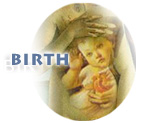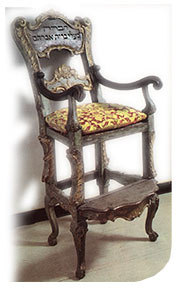|


At the Brit Milah, a special chair, called Kisei Eliyahu
ha-Navi (Chair of Elijah) is designated for Elijah the Prophet.
In some communities a regular chair is used and covered with a special
cloth embroidered with the name "Elijah the Prophet." The designation
of a Chair of Elijah is derived from a tradition that relates to the days
when King Ahab (who reigned over the northern Israelite kingdom from c.
874-852 B.C.E.). abandoned Israel's covenant with God.[1]
Elijah speaks out in pain: "I am moved by zeal for the Lord, the
God of Hosts, for the Israelites have forsaken Your covenant…"[2]
Later tradition equates Elijah's zeal for the covenant with his concern
for the specific commandment of circumcision, since circumcision is the
symbol par excellence of the covenant.
 Fourteenth-century
commentator Rabbi David Abudarham[3]
cites a midrash from the Pirkei d'Rabbi Eliezer[4]
which explains the emerging tradition requiring Elijah's presence at every
brit milah: Fourteenth-century
commentator Rabbi David Abudarham[3]
cites a midrash from the Pirkei d'Rabbi Eliezer[4]
which explains the emerging tradition requiring Elijah's presence at every
brit milah:
Elijah the Prophet,
in his zeal for fulfillment of this mitzvah, took a child and ran away
to a cave. When the Almighty discovered him there and asked Elijah what
he was doing in the cave, Elijah replied: "I was zealous for the
Lord God of Israel in seeing that the children of Israel are transgressing
Your covenant with them. So I have come here to see that this circumcision
is performed." Whereupon the Almighty said to him: "By your
life! Inasmuch as you have been zealous for the commandment of Milah,
every time a circumcision is performed, you will give testimony to the
children of Israel that they shall preserve this mitzvah." Since
that time we include a chair of Elijah, who is known as the Angel of the
Covenant, at the ceremony. [5]
According to this
tradition as it were, God declares to Elijah, zealous "champion of
the covenant," that no Brit milah will take place unless Elijah
oversees that it be performed in accordance with the Almighty's dictates.[6]
If Elijah's presence is an established requirement, providing him with
a symbolic chair at every Brit milah is de rigueur![7]
Others suggest a more
anthropological explanation. The chair of Elijah may be an adaptation
of a local non-Jewish custom of setting aside a chair or table in the
house for a god of fortune who was thought to bring good luck. Talmudic
sages forbade the custom, without success; in the eighth or ninth century
it was legitimized by connecting the chair to Elijah in the manner just
described. Conversely, the dedication of the special chair may be a carryover
from the ancient custom of resting the Torah on a special chair when not
in use. That chair was called the "Cathedra [chair] of Moses."[8]
In communities where
the circumcision ritual is performed in the synagogue, a special chair
is dedicated for this purpose. Regional differences are apparent in the
chair's structural style, size and decoration. However, a chair designated
to be used as a Chair of Elijah is usually much finer than chairs used
in daily life: ornately carved, painted or upholstered in especially beautiful
fabric, it sometimes bears a dedication signifying its special purpose.
To this day, the baby
is placed on the Chair of Elijah at the beginning of the circumcision
ritual, and then on the knees of the sandek. In some communities,
the sandek sits on the Chair during the ritual, whereas in others,
this chair is left empty for the Prophet.[9]
 |
1.
1 Kings 16ff [back]
2.
1
Kings 19:10 [back]
3. David
ben Joseph Abudarham was a liturgical commentator in Spain. His
Sefer Abudarham was written in 1340 in Seville. [back]
4. Pirke
de Rabbi Eliezer is a midrash on Genesis and part of Exodus
and Numbers. It is attributed to Rabbi Eliezer Ben Hyrcannus (late
1st-early 2nd century CE, Israel), the most important student of
Rabban Yohanan Ben Zakkai and head of the Academy in Lod. However,
the final compilation was probably completed in the 8th century,
on the basis of earlier materials. [back]
5. Pirke
de Rabbi Eliezer, chapter 29 [back]
6. Yalkut
Me'am Loez, Sefer Debarim, Alef, pp. 33-34 [back]
7. Rabbi
Herbert C. Dobrinsky "The Life Cycle as Experiences in the
Sephardic Traditions" in Rabbi Marc D. Angel, editor, Exploring
Sephardic Customs and Traditions.( New York: Ktav Publishing
House, Inc, 2000), pp. 57-58. [back]
8. Hyaim
Schauss, The Lifetime of a Jew (New York: Union of American
Hebrew Congregations, 1950), pp. 35-36. [back]
9. Michele
Klein, A Time to be Born (Philadelphia: Jewish Publication
Society of America, 1998), pp.184-85. [back]
|
|
|



